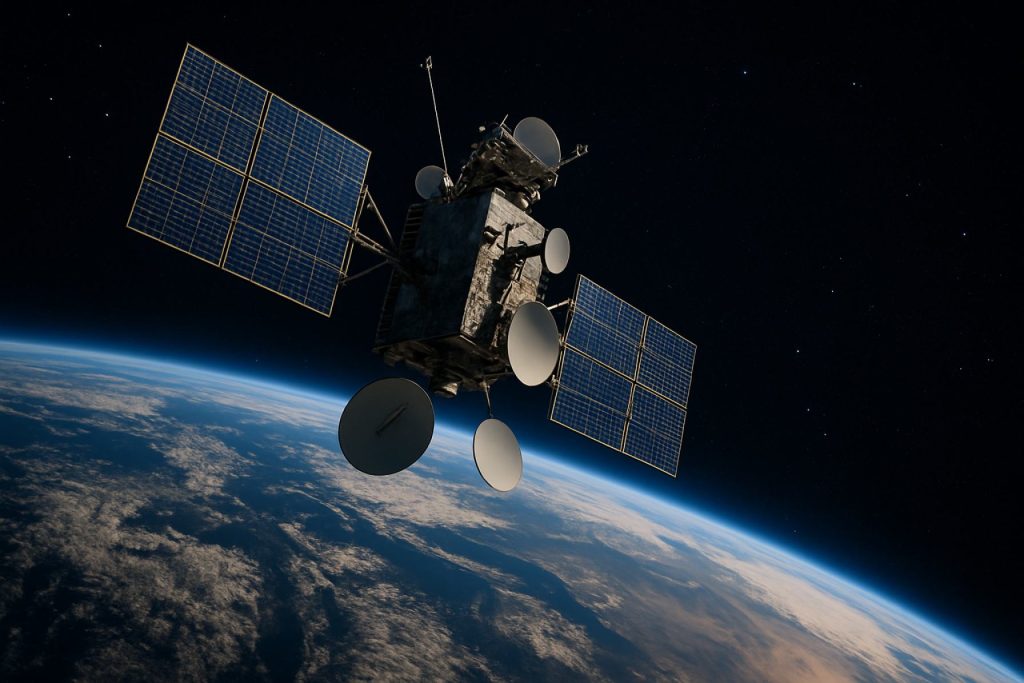
Orbiting at Zero Speed: Unveiling the Power and Influence of Geostationary Satellites in Global Communications
- Market Overview: The Role of Geostationary Satellites in Modern Communications
- Technology Trends: Innovations Shaping Geostationary Satellite Capabilities
- Competitive Landscape: Key Players and Strategic Dynamics
- Growth Forecasts: Projections for Geostationary Satellite Communications
- Regional Analysis: Geostationary Satellite Adoption Across the Globe
- Future Outlook: Evolving Roles and Emerging Applications
- Challenges & Opportunities: Navigating Barriers and Unlocking Potential
- Sources & References
“A geostationary orbit (GEO) is a circular orbit around Earth’s equator at approximately 35,786 km altitude (about 22,236 miles) where a satellite orbits once per sidereal day (~23 hours 56 minutes) in the same direction as Earth’s rotation en.wikipedia.org esa.int.” (source)
Market Overview: The Role of Geostationary Satellites in Modern Communications
Geostationary satellites, orbiting at approximately 35,786 kilometers (22,236 miles) above the Earth’s equator, maintain a fixed position relative to the planet’s surface. This unique characteristic—often described as “orbiting at zero speed” from the perspective of an observer on the ground—enables these satellites to provide continuous, reliable coverage to specific geographic regions. As a result, geostationary satellites (GEOs) have become the backbone of global communications infrastructure, supporting a wide range of applications including television broadcasting, internet connectivity, weather monitoring, and military communications.
According to the International Telecommunication Union (ITU), there are over 400 active geostationary satellites in orbit as of 2024, serving billions of users worldwide. Their stationary position allows for the use of fixed ground antennas, reducing complexity and cost for end-users. This is particularly advantageous for direct-to-home (DTH) television services, which rely on uninterrupted, high-quality signal transmission. In fact, GEO satellites deliver more than 60% of global satellite TV content, according to SES, a leading satellite operator.
In the realm of internet connectivity, geostationary satellites play a crucial role in bridging the digital divide, especially in remote and underserved regions where terrestrial infrastructure is lacking. Companies like Viasat and Hughes have expanded broadband access to millions using GEO platforms. Despite the emergence of low Earth orbit (LEO) constellations, GEO satellites remain indispensable for their wide coverage and established ground infrastructure.
Moreover, geostationary satellites are vital for global weather forecasting and disaster management. The GOES-16 and Meteosat series provide real-time meteorological data, enabling timely warnings and response coordination. The military sector also relies on GEO satellites for secure, high-capacity communications across continents.
In summary, by “orbiting at zero speed,” geostationary satellites offer persistent, high-capacity links that underpin much of the world’s communications infrastructure. Their strategic advantages ensure they will continue to play a dominant role in global connectivity, even as new satellite technologies emerge.
Technology Trends: Innovations Shaping Geostationary Satellite Capabilities
Geostationary satellites, orbiting at approximately 35,786 kilometers above the Earth’s equator, maintain a fixed position relative to the planet’s surface. This unique “zero speed” effect—where the satellite’s orbital period matches the Earth’s rotation—enables continuous coverage over specific geographic regions. As a result, geostationary satellites (GEOs) have become the backbone of global communications, supporting everything from television broadcasting to internet connectivity and emergency response systems.
Recent technological innovations are significantly enhancing the capabilities of GEO satellites. One major trend is the adoption of high-throughput satellite (HTS) technology, which uses spot beam architecture and frequency reuse to dramatically increase data capacity. For example, the ViaSat-3 constellation aims to deliver over 1 Tbps of total network capacity, a leap forward compared to traditional GEO satellites.
Another key development is the integration of digital payloads and software-defined satellites. These allow operators to dynamically reallocate bandwidth and coverage in real time, responding to shifting demand and emergencies. The SES-17 satellite, launched in 2021, features a fully digital payload, enabling flexible service delivery across the Americas and the Atlantic Ocean.
Inter-satellite links and hybrid architectures are also shaping the future of GEO communications. By connecting GEO satellites with low Earth orbit (LEO) and medium Earth orbit (MEO) constellations, operators can offer lower latency and more resilient global coverage. Companies like Intelsat are pioneering multi-orbit solutions that blend the strengths of GEO and non-GEO assets.
Despite the rise of LEO constellations, GEO satellites remain indispensable for wide-area, persistent coverage—especially in remote or underserved regions. According to the NSR Geostationary Satellite Market Outlook 2023, GEOs are expected to account for over 60% of global satellite communications revenue through 2030, underscoring their enduring role in the industry.
- High-throughput and digital payloads are revolutionizing GEO capacity and flexibility.
- Hybrid multi-orbit networks are emerging to combine GEO’s reach with LEO’s low latency.
- GEO satellites continue to dominate global communications, especially for broadcast and wide-area connectivity.
Competitive Landscape: Key Players and Strategic Dynamics
Geostationary satellites (GEOs) have long been the backbone of global communications, providing continuous coverage over fixed regions of the Earth. Positioned approximately 35,786 kilometers above the equator, these satellites orbit at the same rotational speed as the Earth, appearing stationary to ground observers. This unique characteristic enables uninterrupted connectivity for television broadcasting, weather monitoring, military communications, and broadband internet services.
The competitive landscape in the GEO satellite market is dominated by a handful of major players, each leveraging advanced technologies and strategic partnerships to maintain their market share. SES S.A. and Intelsat are two of the largest operators, collectively managing hundreds of transponders and serving clients across media, government, and enterprise sectors. Eutelsat and Telesat also play significant roles, particularly in Europe and the Americas, respectively.
According to a recent MarketsandMarkets report, the global satellite communication market is projected to grow from $71.6 billion in 2023 to $137.5 billion by 2028, with GEO satellites accounting for a substantial portion of this expansion. The demand is driven by increasing data consumption, the proliferation of high-definition content, and the need for reliable connectivity in remote areas.
Strategically, key players are investing in high-throughput satellites (HTS) and digital payload technologies to enhance capacity and flexibility. For example, SES’s O3b mPOWER and Eutelsat’s KONNECT satellites are designed to deliver multi-gigabit speeds and dynamic bandwidth allocation. Partnerships with launch providers like SpaceX and Arianespace further streamline deployment and reduce costs.
Despite the rise of low Earth orbit (LEO) constellations such as Starlink, GEO satellites retain a competitive edge in serving high-capacity, fixed-location applications and regions with limited terrestrial infrastructure. The strategic dynamics in this sector are thus defined by a blend of technological innovation, global reach, and the ability to adapt to evolving customer needs.
Growth Forecasts: Projections for Geostationary Satellite Communications
Geostationary satellites, orbiting at approximately 35,786 kilometers above the Earth’s equator, maintain a fixed position relative to the planet’s surface. This unique characteristic—often described as “orbiting at zero speed” from the ground perspective—enables them to provide continuous, reliable coverage to specific regions. As a result, geostationary satellites (GEOs) have long been the backbone of global communications, supporting everything from television broadcasting and internet connectivity to military and emergency services.
Despite the rise of low Earth orbit (LEO) constellations, GEO satellites continue to dominate key segments of the satellite communications market. According to a recent report by NSR, the global GEO communications market is projected to generate over $20 billion in annual revenues by 2031, driven by demand for high-throughput satellites (HTS) and the expansion of broadband services in underserved regions.
- Capacity Expansion: The deployment of next-generation GEO satellites, such as Viasat-3 and SES-17, is expected to significantly increase available bandwidth. These satellites offer terabit-level throughput, enabling faster and more affordable connectivity for enterprise, maritime, and aviation customers (SES).
- Market Segments: GEO satellites remain critical for broadcast television, which still accounts for a substantial portion of satellite transponder demand. In 2023, satellite TV services reached over 1.5 billion viewers worldwide (Satellite Today).
- Emerging Applications: The integration of GEO satellites with LEO and medium Earth orbit (MEO) systems is fostering hybrid networks, enhancing global coverage and resilience. This trend is expected to accelerate, with hybrid architectures projected to account for 30% of satellite communications traffic by 2028 (Euroconsult).
While LEO constellations offer lower latency, GEO satellites’ ability to deliver uninterrupted, wide-area coverage ensures their continued relevance. As technology advances and demand for global connectivity grows, geostationary satellites are poised to remain a cornerstone of the communications landscape, supporting both legacy and next-generation services worldwide.
Regional Analysis: Geostationary Satellite Adoption Across the Globe
Geostationary satellites, orbiting at approximately 35,786 kilometers above the Earth’s equator, maintain a fixed position relative to the planet’s surface. This unique characteristic—often described as “orbiting at zero speed” from the ground perspective—makes them indispensable for global communications. Their ability to provide continuous coverage to specific regions has cemented their role in broadcasting, internet connectivity, weather monitoring, and defense applications worldwide.
As of 2023, there are over 400 active geostationary satellites, with the majority operated by commercial entities and government agencies in North America, Europe, and Asia (Union of Concerned Scientists). The Asia-Pacific region leads in new deployments, driven by expanding telecommunications infrastructure in countries like India, China, and Indonesia. For instance, India’s GSAT series and China’s Chinasat constellation have significantly increased regional capacity, supporting both rural connectivity and national security objectives (Space.com).
In North America, geostationary satellites remain the backbone of television broadcasting and broadband services, especially in remote and underserved areas. Major operators such as Intelsat, SES, and Eutelsat continue to invest in high-throughput satellites (HTS) to meet growing data demands (Intelsat). Europe, meanwhile, leverages geostationary assets for both commercial and governmental purposes, with the European Space Agency (ESA) supporting initiatives like the GovSat program for secure communications (ESA).
- Latin America: Geostationary satellites are vital for bridging the digital divide, with operators like Hispasat and Star One expanding coverage to rural and isolated communities.
- Africa: Adoption is accelerating, with satellites such as NigComSat-1R and AMOS-17 providing essential connectivity for education, healthcare, and disaster response (NigComSat).
- Middle East: Countries like the UAE and Saudi Arabia are investing in indigenous satellite programs to enhance national security and economic diversification.
Despite the rise of low Earth orbit (LEO) constellations, geostationary satellites remain irreplaceable for wide-area, persistent coverage. Their strategic positioning and technological advancements ensure they continue to rule global communications, particularly in regions where terrestrial infrastructure is limited or unreliable.
Future Outlook: Evolving Roles and Emerging Applications
Geostationary satellites, positioned approximately 35,786 kilometers above the Earth’s equator, maintain a fixed position relative to the planet’s surface by orbiting at the same rotational speed as the Earth. This unique capability has made them the backbone of global communications for decades, supporting everything from television broadcasting to internet connectivity and weather monitoring. As the demand for seamless, high-capacity, and low-latency communications grows, the role of geostationary satellites is evolving, with new applications and technological advancements shaping their future outlook.
- Expanding Connectivity: Geostationary satellites continue to play a critical role in bridging the digital divide, especially in remote and underserved regions where terrestrial infrastructure is lacking. According to the International Telecommunication Union (ITU), nearly 2.6 billion people remain offline as of 2023, highlighting the ongoing need for satellite-based solutions.
- Emerging Applications: The next generation of geostationary satellites is being designed to support high-throughput data services, enabling applications such as 4K/8K video streaming, telemedicine, and disaster response. For instance, the SES-17 satellite, launched in 2021, delivers high-speed internet to commercial aviation and maritime sectors, demonstrating the expanding scope of GEO satellite services.
- Integration with Non-GEO Constellations: While low Earth orbit (LEO) constellations like Starlink and OneWeb are gaining attention for their low-latency capabilities, industry experts foresee a hybrid future where GEO, MEO, and LEO satellites work in tandem. This integrated approach is expected to optimize coverage, capacity, and reliability for global communications networks (SpaceNews).
- Technological Innovations: Advances in digital payloads, beamforming, and software-defined satellites are enhancing the flexibility and efficiency of geostationary platforms. These innovations allow operators to dynamically allocate bandwidth and adapt to shifting user demands, ensuring GEO satellites remain competitive in a rapidly changing market (Euroconsult).
In summary, while the satellite communications landscape is diversifying, geostationary satellites are poised to retain a pivotal role. Their ability to provide persistent, wide-area coverage and support emerging high-bandwidth applications ensures they will continue to rule global communications, even as new technologies and orbital regimes come online.
Challenges & Opportunities: Navigating Barriers and Unlocking Potential
Geostationary satellites, positioned approximately 35,786 kilometers above the Earth’s equator, have long been the backbone of global communications. Their unique orbital position allows them to match the Earth’s rotation, appearing stationary relative to a fixed point on the surface. This “zero speed” relative to the ground enables continuous coverage over vast areas, making them indispensable for television broadcasting, weather monitoring, and international telecommunications (European Space Agency).
Challenges
- Latency: The significant distance from Earth introduces a round-trip latency of about 500 milliseconds, which can hinder real-time applications such as online gaming, video conferencing, and certain financial transactions (Intelsat).
- Orbital Congestion: The geostationary belt is a limited resource, with only about 180 slots available for satellites. Increasing demand for bandwidth and new services is intensifying competition for these positions, raising concerns about interference and space debris (ITU).
- High Launch and Maintenance Costs: Deploying and maintaining geostationary satellites requires significant capital investment, with launch costs alone often exceeding $100 million per satellite (SpaceNews).
- Technological Obsolescence: With a typical lifespan of 15 years, geostationary satellites risk becoming outdated as ground-based and low Earth orbit (LEO) technologies advance rapidly.
Opportunities
- Global Coverage: A single geostationary satellite can cover up to one-third of the Earth’s surface, making it ideal for broadcasting and connecting remote or underserved regions (SES).
- Resilience and Redundancy: Geostationary satellites provide critical backup for terrestrial networks, especially during natural disasters or geopolitical disruptions.
- Emerging Markets: Growing demand for broadband in Africa, Asia, and Latin America presents new revenue streams for satellite operators, particularly as governments and enterprises seek to bridge the digital divide (NASASpaceflight).
- Hybrid Networks: Integration with LEO and medium Earth orbit (MEO) constellations can mitigate latency issues and expand service offerings, creating a more robust and flexible global communications infrastructure.
While geostationary satellites face mounting challenges from new technologies and market dynamics, their unique advantages ensure they remain a cornerstone of global communications, especially as operators innovate to unlock new opportunities.
Sources & References
- Orbiting at Zero Speed: How Geostationary Satellites Rule Global Communications
- ITU
- SES
- GOES-16
- Meteosat
- Intelsat
- NSR
- Telesat
- MarketsandMarkets
- Arianespace
- Starlink
- Satellite Today
- Euroconsult
- Union of Concerned Scientists
- Space.com
- European Space Agency
- NigComSat
- SpaceNews
- NASASpaceflight



